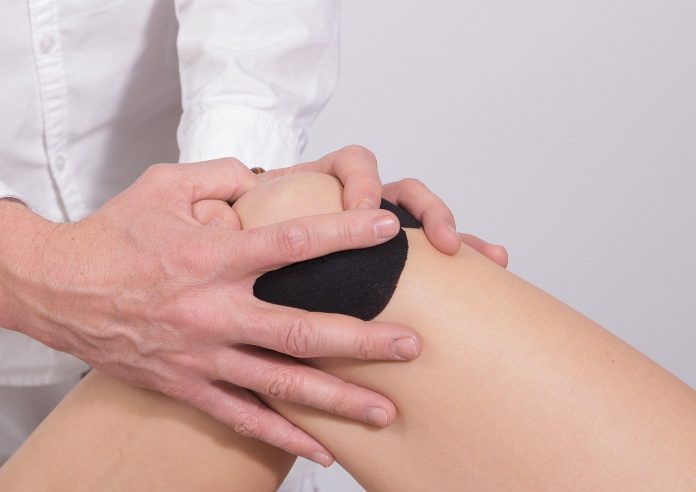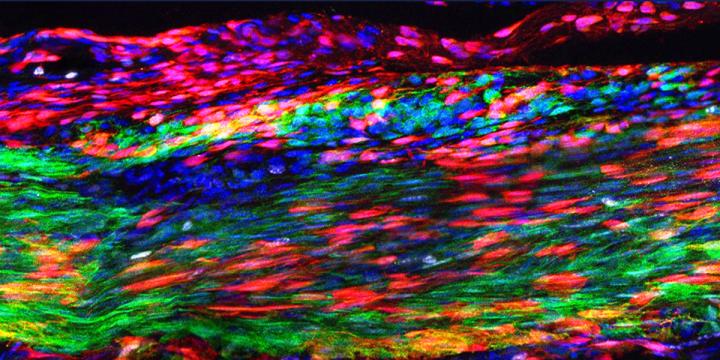Staminali nel ginocchio, il futuro della cura delle lesioni al tendine? / Stem in the knee, the future of treating tendon injuries?
Staminali nel ginocchio, il futuro della cura delle lesioni al tendine? / Stem in the knee, the future of treating tendon injuries?
Segnalato dal Dott. Giuseppe Cotellessa / Reported by Dr. Giuseppe Cotellessa

Ricercate, studiate e ricostruite in laboratorio: le cellule staminali promettono molto al futuro della medicina, per la loro capacità di rigenerare il tessuto cui appartengono. Finora però non le avevamo ancora trovate nel tendine rotuleo. Anzi si pensava proprio che lì non potessero esistere delle staminali capaci di riconvertirsi in cellule tissutali del tendine, poiché il tendine, una volta rotto, è così difficile da riparare. E invece sono state individuate dai ricercatori del Carniege Institute for Science di Washington, il cui studio è apparso su Nature Cell Biology. La scoperta potrebbe in futuro migliorare le terapie di recupero ed evitare interventi chirurgici.
Un tendine senza staminali
I giocatori di calcio sanno che sollecitare troppo le ginocchia può portare al cosiddetto ginocchio del saltatore, una lesione del tendine che unisce la rotula alla tibia. Non è l’unica lesione dolorosa che capita al tendine e spesso questi problemi chiedono un lungo e complesso recupero. Spesso bisogna intervenire chirurgicamente e il più delle volte non è possibile recuperare totalmente perché si accumula del tessuto fibroso che cicatrizza la rottura, impedendo che il tendine torni allo stato precedente e peggiorando la mobilità del paziente. Proprio per le difficoltà di recupero si era sempre pensato, perciò, che non ci fossero delle cellule staminali capaci di rigenerare il tessuto del tendine, come spiega Tyler Harvey, tra gli autori della ricerca. “Le rotture del tendine raramente si risistemano del tutto e si pensava che le staminali del tendine non dovessero esistere. Molti le hanno cercate senza successo, ma il nostro lavoro le individuate per la prima volta”.

L’immagine mostra il tendine rotuleo 30 giorni dopo una lesione. I punti rossi indicano le cellule staminali, quelli verdi le cellule tendinee. / The image shows the patellar tendon 30 days after an injury. The red points indicate the stem cells, the green ones the tendinous cells. Crediti foto: Tayler Harvey
La scoperta
E invece si trovavano sotto le cellule protettive che cingono il tendine. Queste staminali sono cellule che non si sono ancora del tutto differenziate in una specifica funzione. In altre parole, non si sono ancora specializzate e dunque potrebbero aiutare a ricostruire quasi qualsiasi tipo di tessuto, anche indirettamente, per esmepio aiutando a spegnere i processi infiammatori. Per questa ragione sono molto importanti per il nostro corpo e la ricerca medica se ne interessa molto: uno studio recente, per esempio, avanza l’ipotesi che delle cellule staminali del midollo possano essere utili per il recupero delle cellule cerebrali dopo un ictus. E oggi sappiamo che questo potrebbe valere anche per il tessuto del tendine rotuleo.
Come si attivano le staminali
Eppure queste cellule non entrano in azione nel caso di rottura del tendine e lasciano il posto al tessuto cicatriziale. Come mai? Quello che hanno scoperto gli studiosi è che nel luogo in cui si trovano queste staminali si originano proprio anche le cellule del tessuto cicatriziale, che rimpiazza il normale tessuto del tendine in caso di lesione, peggiorando l’elasticità e aumentando il fastidio. Il problema è che i due gruppi di cellule si trovano in un sistema competitivo, per così dire le une contro le altre. “Insomma – aggiunge Chen-Ming Fan, che ha guidato il gruppo di ricerca – le staminali esistono ma devono gareggiare con le cellule del tessuto cicatriziale per impedire la formazione della cicatrice”.
Entrambi i tipi di cellule sono infatti attivati da una proteina particolare chiamata fattore di crescita derivato dalle piastrine. Ma, raccontano i ricercatori, quando le cellule staminali del tendine sono alterate così da non rispondere al fattore di crescita, allora, dopo una lesione, si svilupperanno soltanto le cellule cicatriziali e nessuna nuova cellula tendinea.
Perciò, conclude Fan, “trovare una via terapeutica per bloccare le cellule responsabili della formazione della cicatrice e potenziare le cellule staminali potrebbe cambiare le carte in tavola quando bisogna curare una rottura del tendine”.
ENGLISH
Researched, studied and reconstructed in the laboratory: stem cells promise much to the future of medicine, due to their ability to regenerate the tissue to which they belong. So far, however, we had not yet found them in the patellar tendon. Indeed it was thought that there could be no stem cells capable of reconverting into tissue cells in the tendon, since the tendon, once broken, is so difficult to repair. Instead, they were identified by researchers at the Carniege Institute for Science in Washington, whose study appeared in Nature Cell Biology. The discovery could improve recovery therapies and avoid surgical interventions in the future.
A tendon without stem cells
Football players know that stressing the knees too much can lead to the so-called jumper's knee, a tendon injury that joins the kneecap to the tibia. It is not the only painful lesion that occurs in the tendon and often these problems require a long and complex recovery. Often it is necessary to intervene surgically and most of the times it is not possible to recover completely because the fibrous tissue that heals the rupture accumulates, preventing the tendon from returning to its previous state and worsening the patient's mobility. Precisely because of the difficulties of recovery it was always thought, therefore, that there were no stem cells capable of regenerating tendon tissue, as Tyler Harvey explains, among the authors of the research. "The tendon ruptures are rarely completely restored and it was thought that tendon stems should not exist. Many have searched for them without success, but our work identified them for the first time ”.
The discovery
And instead they were under the protective cells surrounding the tendon. These stem cells are cells that have not yet completely differentiated into a specific function. In other words, they have not yet specialized and therefore could help rebuild almost any type of tissue, even indirectly, for example by helping to shut down inflammatory processes. For this reason they are very important for our body and medical research is very interested in it: a recent study, for example, advances the hypothesis that marrow stem cells can be useful for the recovery of brain cells after a stroke. And today we know that this could also apply to the patellar tendon tissue.
How stem cells are activated
Yet these cells do not come into action in the event of tendon rupture and leave the place for scar tissue. Why? What researchers have discovered is that in the place where these stem cells are found, the cells of the scar tissue also originate, replacing the normal tendon tissue in case of injury, worsening elasticity and increasing discomfort. The problem is that the two groups of cells are in a competitive system, so to speak against each other. "In short - adds Chen-Ming Fan, who led the research group - stem cells exist but must compete with scar tissue cells to prevent scar formation".
Both types of cells are in fact activated by a particular protein called platelet-derived growth factor. But, the researchers say, when the tendon stem cells are altered so as not to respond to the growth factor, then, after a lesion, only the scar cells and no new tendon cells will develop.
Therefore, Fan concludes, "finding a therapeutic pathway to block the cells responsible for scar formation and strengthen stem cells could change the cards on the table when curing a tendon is needed".
Da:



Commenti
Posta un commento